coolant Alfa Romeo Brera/Spider 2010 Owner handbook (in English)
[x] Cancel search | Manufacturer: ALFA ROMEO, Model Year: 2010, Model line: Brera/Spider, Model: Alfa Romeo Brera/Spider 2010Pages: 271, PDF Size: 4.45 MB
Page 9 of 271
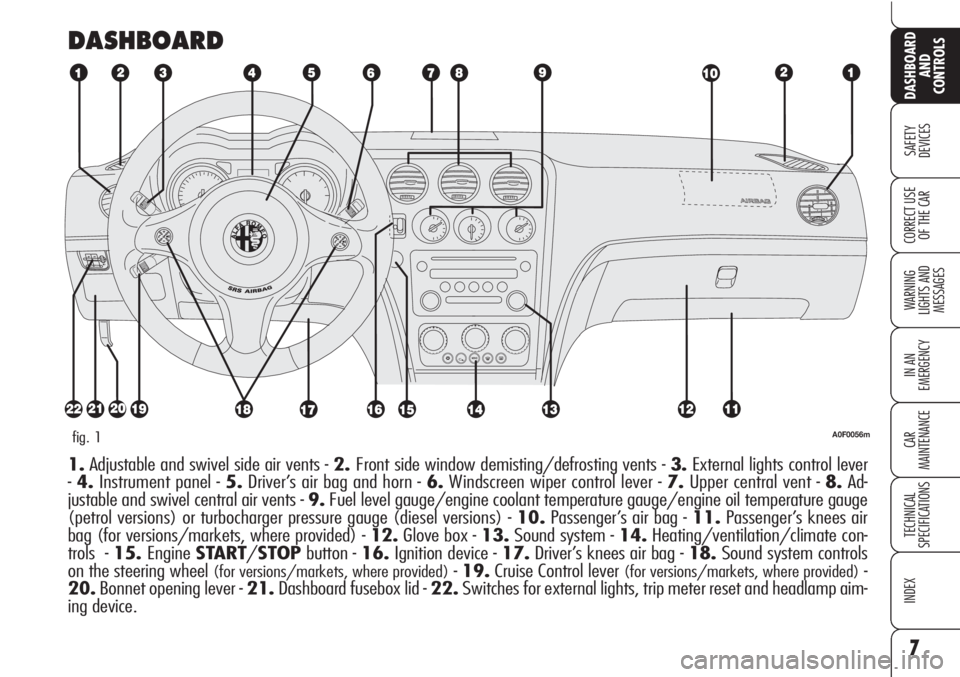
7
SAFETY
DEVICES
WARNING
LIGHTS AND
MESSAGES
IN AN
EMERGENCY
CAR
MAINTENANCE
TECHNICAL
SPECIFICATIONS
INDEX
DASHBOARD
AND
CONTROLS
CORRECT USE
OF THE CAR
DASHBOARD
A0F0056mfig. 1
1.Adjustable and swivel side air vents - 2.Front side window demisting/defrosting vents - 3.External lights control lever
-4.Instrument panel - 5.Driver’s air bag and horn - 6.Windscreen wiper control lever - 7.Upper central vent - 8.Ad-
justable and swivel central air vents - 9.Fuel level gauge/engine coolant temperature gauge/engine oil temperature gauge
(petrol versions) or turbocharger pressure gauge (diesel versions) - 10.Passenger’s air bag - 11.Passenger’s knees air
bag (for versions/markets, where provided) - 12.Glove box - 13.Sound system - 14.Heating/ventilation/climate con-
trols - 15.EngineSTART/STOPbutton - 16.Ignition device - 17.Driver’s knees air bag - 18.Sound system controls
on the steering wheel
(for versions/markets, where provided)-19.Cruise Control lever (for versions/markets, where provided)-
20.Bonnet opening lever - 21.Dashboard fusebox lid - 22.Switches for external lights, trip meter reset and headlamp aim-
ing device.
Page 25 of 271

23
SAFETY
DEVICES
WARNING
LIGHTS AND
MESSAGES
IN AN
EMERGENCY
CAR
MAINTENANCE
TECHNICAL
SPECIFICATIONS
INDEX
DASHBOARD
AND
CONTROLS
CORRECT USE
OF THE CAR
IMPORTANTUnder certain conditions
(heavy slopes, for instance), the reading
on the gauge may differ from the actual
amount of fuel in the tank and changes
in level may be indicated late. This con-
dition falls within the regular operating log-
ics of the fuel gauge.The turning on of the warning light u
(together with a message on the dis-
play) indicates that the coolant fluid
temperature is too high; in this case,
stop the engine and contact Alfa Romeo
Authorized Services.
IMPORTANTThe temperature of the
engine coolant may rise towards the
maximum values (red sector) when the
car is driven at low speeds, uphill, fully
laden or during towing, especially if the
ambient temperature is high.
A0F0178mfig. 16
ENGINE COOLANT
TEMPERATURE GAUGE
fig. 16
This shows the temperature of the en-
gine coolant fluid and begins working
when the fluid temperature exceeds ap-
prox. 50°C.
The pointer should normally be towards
the middle of the scale. If the pointer
reaches the red sector, reduce your de-
mand on the engine.
Page 27 of 271
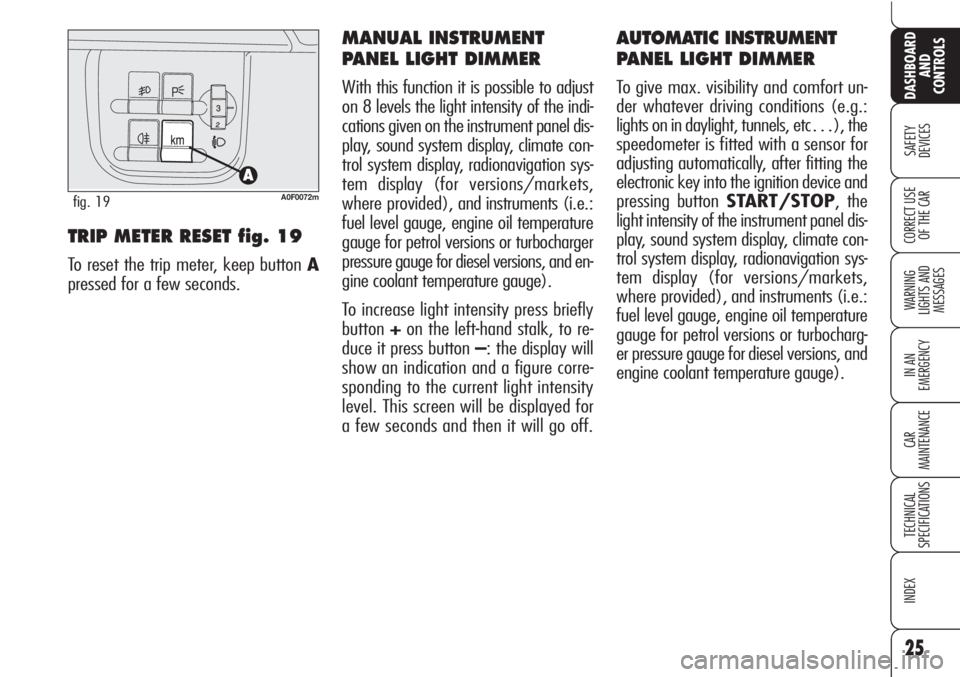
25
SAFETY
DEVICES
WARNING
LIGHTS AND
MESSAGES
IN AN
EMERGENCY
CAR
MAINTENANCE
TECHNICAL
SPECIFICATIONS
INDEX
DASHBOARD
AND
CONTROLS
CORRECT USE
OF THE CAR
AUTOMATIC INSTRUMENT
PANEL LIGHT DIMMER
To give max. visibility and comfort un-
der whatever driving conditions (e.g.:
lights on in daylight, tunnels, etc…), the
speedometer is fitted with a sensor for
adjusting automatically, after fitting the
electronic key into the ignition device and
pressing button START/STOP, the
light intensity of the instrument panel dis-
play, sound system display, climate con-
trol system display, radionavigation sys-
tem display (for versions/markets,
where provided), and instruments (i.e.:
fuel level gauge, engine oil temperature
gauge for petrol versions or turbocharg-
er pressure gauge for diesel versions, and
engine coolant temperature gauge).
TRIP METER RESET fig. 19
To reset the trip meter, keep button A
pressed for a few seconds.
MANUAL INSTRUMENT
PANEL LIGHT DIMMER
With this function it is possible to adjust
on 8 levels the light intensity of the indi-
cations given on the instrument panel dis-
play, sound system display, climate con-
trol system display, radionavigation sys-
tem display (for versions/markets,
where provided), and instruments (i.e.:
fuel level gauge, engine oil temperature
gauge for petrol versions or turbocharger
pressure gauge for diesel versions, and en-
gine coolant temperature gauge).
To increase light intensity press briefly
button+on the left-hand stalk, to re-
duce it press button –: the display will
show an indication and a figure corre-
sponding to the current light intensity
level. This screen will be displayed for
a few seconds and then it will go off.
A0F0072mfig. 19
Page 143 of 271
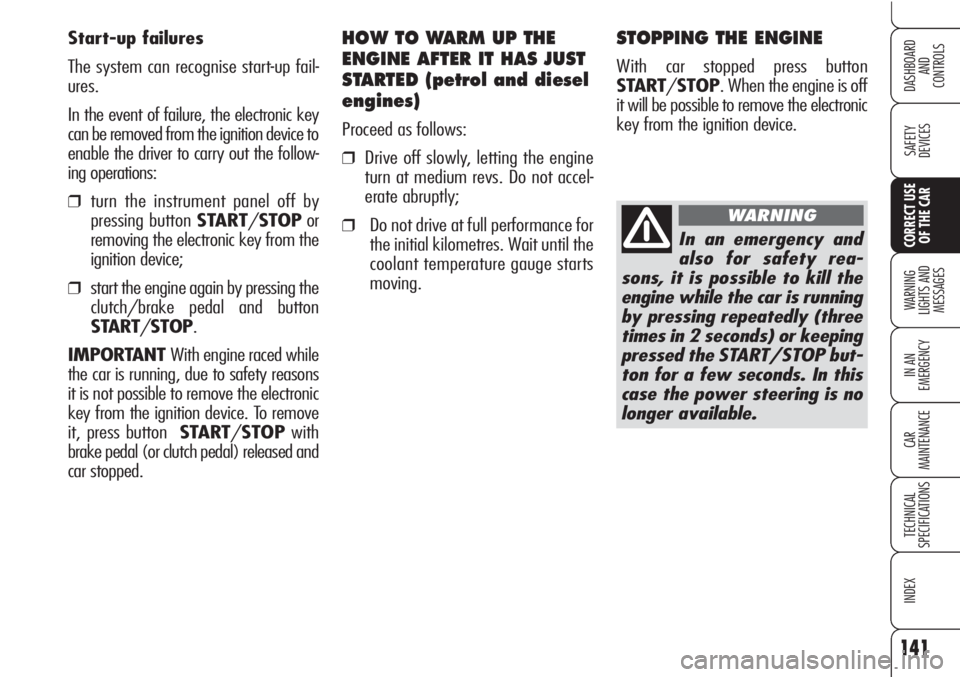
141
SAFETY
DEVICES
WARNING
LIGHTS AND
MESSAGES
IN AN
EMERGENCY
CAR
MAINTENANCE
TECHNICAL
SPECIFICATIONS
INDEX
DASHBOARD
AND
CONTROLS
CORRECT USE
OF THE CAR
Start-up failures
The system can recognise start-up fail-
ures.
In the event of failure, the electronic key
can be removed from the ignition device to
enable the driver to carry out the follow-
ing operations:
❒turn the instrument panel off by
pressing button START/STOPor
removing the electronic key from the
ignition device;
❒start the engine again by pressing the
clutch/brake pedal and button
START/STOP.
IMPORTANT With engine raced while
the car is running, due to safety reasons
it is not possible to remove the electronic
key from the ignition device. To remove
it, press buttonSTART/STOPwith
brake pedal (or clutch pedal) released and
car stopped.
HOW TO WARM UP THE
ENGINE AFTER IT HAS JUST
STARTED (petrol and diesel
engines)
Proceed as follows:
❒Drive off slowly, letting the engine
turn at medium revs. Do not accel-
erate abruptly;
❒Do not drive at full performance for
the initial kilometres. Wait until the
coolant temperature gauge starts
moving.
STOPPING THE ENGINE
With car stopped press button
START/STOP. When the engine is off
it will be possible to remove the electronic
key from the ignition device.
In an emergency and
also for safety rea-
sons, it is possible to kill the
engine while the car is running
by pressing repeatedly (three
times in 2 seconds) or keeping
pressed the START/STOP but-
ton for a few seconds. In this
case the power steering is no
longer available.
WARNING
Page 153 of 271
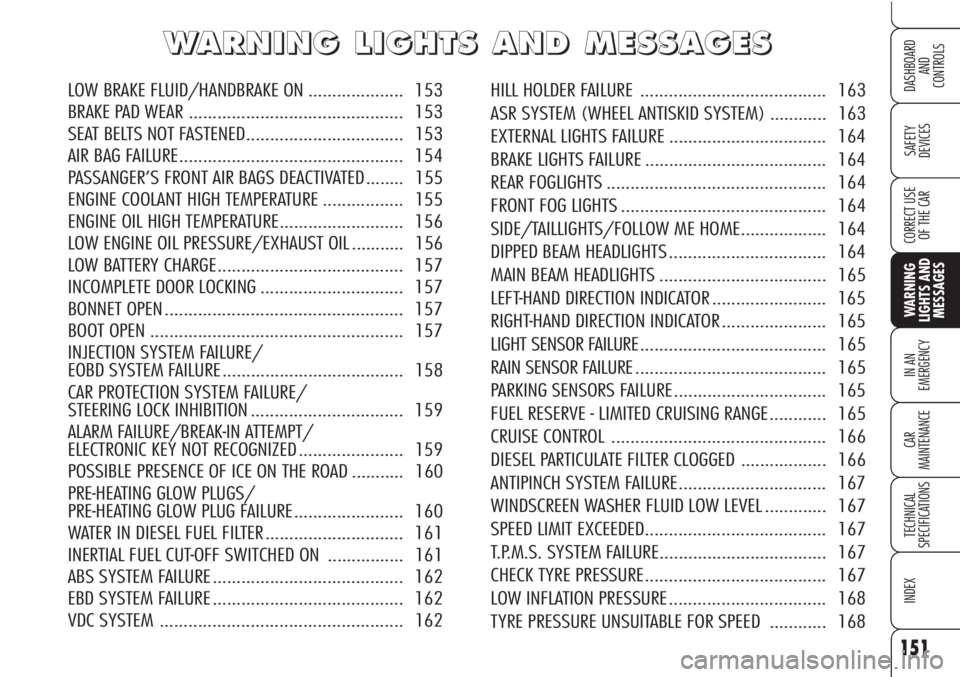
151
SAFETY
DEVICES
WARNING
LIGHTS AND
MESSAGES
IN AN
EMERGENCY
CAR
MAINTENANCE
TECHNICAL
SPECIFICATIONS
INDEX
DASHBOARD
AND
CONTROLS
CORRECT USE
OF THE CAR
W W
A A
R R
N N
I I
N N
G G
L L
I I
G G
H H
T T
S S
A A
N N
D D
M M
E E
S S
S S
A A
G G
E E
S S
LOW BRAKE FLUID/HANDBRAKEON .................... 153
BRAKE PAD WEAR ............................................. 153
SEAT BELTS NOT FASTENED................................. 153
AIR BAG FAILURE............................................... 154
PASSANGER’S FRONT AIR BAGS DEACTIVATED ........ 155
ENGINE COOLANT HIGH TEMPERATURE ................. 155
ENGINE OIL HIGH TEMPERATURE.......................... 156
LOW ENGINE OIL PRESSURE/EXHAUST OIL ........... 156
LOW BATTERY CHARGE....................................... 157
INCOMPLETE DOOR LOCKING .............................. 157
BONNET OPEN.................................................. 157
BOOT OPEN..................................................... 157
INJECTION SYSTEM FAILURE/
EOBD SYSTEM FAILURE...................................... 158
CAR PROTECTION SYSTEM FAILURE/
STEERING LOCK INHIBITION ................................ 159
ALARM FAILURE/BREAK-IN ATTEMPT/
ELECTRONIC KEY NOT RECOGNIZED ...................... 159
POSSIBLE PRESENCE OF ICE ON THE ROAD ........... 160
PRE-HEATING GLOW PLUGS/
PRE-HEATING GLOW PLUG FAILURE....................... 160
WATER IN DIESEL FUEL FILTER ............................. 161
INERTIAL FUEL CUT-OFF SWITCHED ON ................ 161
ABS SYSTEM FAILURE ........................................ 162
EBD SYSTEM FAILURE ........................................ 162
VDC SYSTEM ................................................... 162HILL HOLDER FAILURE ....................................... 163
ASR SYSTEM (WHEEL ANTISKID SYSTEM) ............ 163
EXTERNAL LIGHTS FAILURE ................................. 164
BRAKE LIGHTS FAILURE ...................................... 164
REAR FOGLIGHTS.............................................. 164
FRONT FOG LIGHTS........................................... 164
SIDE/TAILLIGHTS/FOLLOW ME HOME.................. 164
DIPPED BEAM HEADLIGHTS ................................. 164
MAIN BEAM HEADLIGHTS ................................... 165
LEFT-HAND DIRECTION INDICATOR ........................ 165
RIGHT-HAND DIRECTION INDICATOR ...................... 165
LIGHT SENSOR FAILURE....................................... 165
RAIN SENSOR FAILURE........................................ 165
PARKING SENSORS FAILURE................................ 165
FUEL RESERVE - LIMITED CRUISING RANGE............ 165
CRUISE CONTROL............................................. 166
DIESEL PARTICULATE FILTER CLOGGED .................. 166
ANTIPINCH SYSTEM FAILURE............................... 167
WINDSCREEN WASHER FLUID LOW LEVEL ............. 167
SPEED LIMIT EXCEEDED...................................... 167
T.P.M.S. SYSTEM FAILURE................................... 167
CHECK TYRE PRESSURE...................................... 167
LOW INFLATION PRESSURE................................. 168
TYRE PRESSURE UNSUITABLE FOR SPEED ............ 168
Page 157 of 271
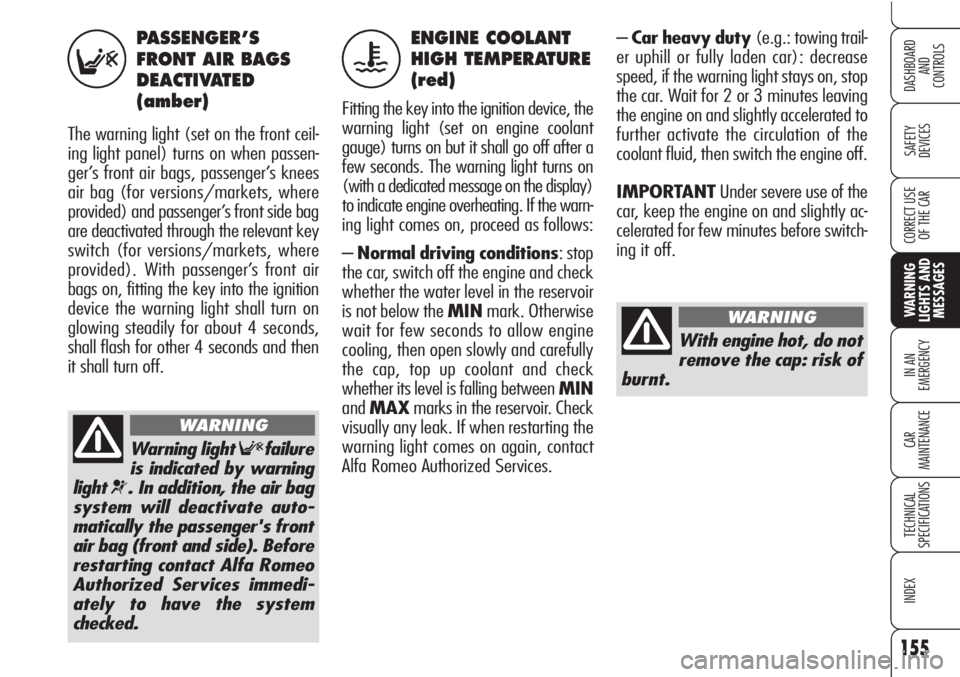
155
SAFETY
DEVICES
WARNING
LIGHTS AND
MESSAGES
IN AN
EMERGENCY
CAR
MAINTENANCE
TECHNICAL
SPECIFICATIONS
INDEX
DASHBOARD
AND
CONTROLS
CORRECT USE
OF THE CAR
PASSENGER’S
FRONT AIR BAGS
DEACTIVATED
(amber)
The warning light (set on the front ceil-
ing light panel) turns on when passen-
ger’s front air bags, passenger’s knees
air bag (for versions/markets, where
provided) and passenger’s front side bag
are deactivated through the relevant key
switch (for versions/markets, where
provided). With passenger’s front air
bags on, fitting the key into the ignition
device the warning light shall turn on
glowing steadily for about 4 seconds,
shall flash for other 4 seconds and then
it shall turn off.
F
–Car heavy duty (e.g.: towing trail-
er uphill or fully laden car): decrease
speed, if the warning light stays on, stop
the car. Wait for 2 or 3 minutes leaving
the engine on and slightly accelerated to
further activate the circulation of the
coolant fluid, then switch the engine off.
IMPORTANTUnder severe use of the
car, keep the engine on and slightly ac-
celerated for few minutes before switch-
ing it off.
Warning light Ffailure
is indicated by warning
light
¬. In addition, the air bag
system will deactivate auto-
matically the passenger's front
air bag (front and side). Before
restarting contact Alfa Romeo
Authorized Services immedi-
ately to have the system
checked.
WARNING
ENGINE COOLANT
HIGH TEMPERATURE
(red)
Fitting the key into the ignition device, the
warning light (set on engine coolant
gauge) turns on but it shall go off after a
few seconds. The warning light turns on
(with a dedicated message on the display)
to indicate engine overheating. If the warn-
ing light comes on, proceed as follows:
–Normal driving conditions: stop
the car, switch off the engine and check
whether the water level in the reservoir
is not below the MINmark. Otherwise
wait for few seconds to allow engine
cooling, then open slowly and carefully
the cap, top up coolant and check
whether its level is falling between MIN
andMAXmarks in the reservoir. Check
visually any leak. If when restarting the
warning light comes on again, contact
Alfa Romeo Authorized Services.
u
With engine hot, do not
remove the cap: risk of
burnt.
WARNING
Page 213 of 271
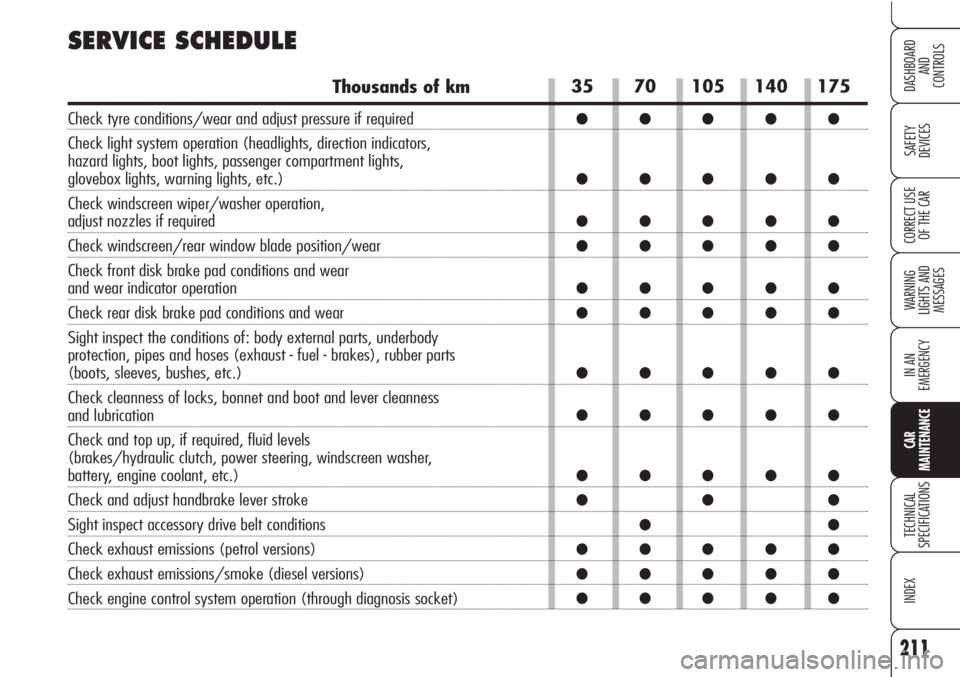
211
SAFETY
DEVICES
WARNING
LIGHTS AND
MESSAGES
IN AN
EMERGENCY
CAR
MAINTENANCE
TECHNICAL
SPECIFICATIONS
INDEX
DASHBOARD
AND
CONTROLS
CORRECT USE
OF THE CAR
35 70 105 140 175
●●●●●
●●●●●
●●●●●
●●●●●
●●●●●
●●●●●
●●●●●
●●●●●
●●●●●
●●●
●●
●●●●●
●●●●●
●●●●●
SERVICE SCHEDULE
Thousands of km
Check tyre conditions/wear and adjust pressure if required
Check light system operation (headlights, direction indicators,
hazard lights, boot lights, passenger compartment lights,
glovebox lights, warning lights, etc.)
Check windscreen wiper/washer operation,
adjust nozzles if required
Check windscreen/rear window blade position/wear
Check front disk brake pad conditions and wear
and wear indicator operation
Check rear disk brake pad conditions and wear
Sight inspect the conditions of: body external parts, underbody
protection, pipes and hoses (exhaust - fuel - brakes), rubber parts
(boots, sleeves, bushes, etc.)
Check cleanness of locks, bonnet and boot and lever cleanness
and lubrication
Check and top up, if required, fluid levels
(brakes/hydraulic clutch, power steering, windscreen washer,
battery, engine coolant, etc.)
Check and adjust handbrake lever stroke
Sight inspect accessory drive belt conditions
Check exhaust emissions (petrol versions)
Check exhaust emissions/smoke (diesel versions)
Check engine control system operation (through diagnosis socket)
Page 215 of 271
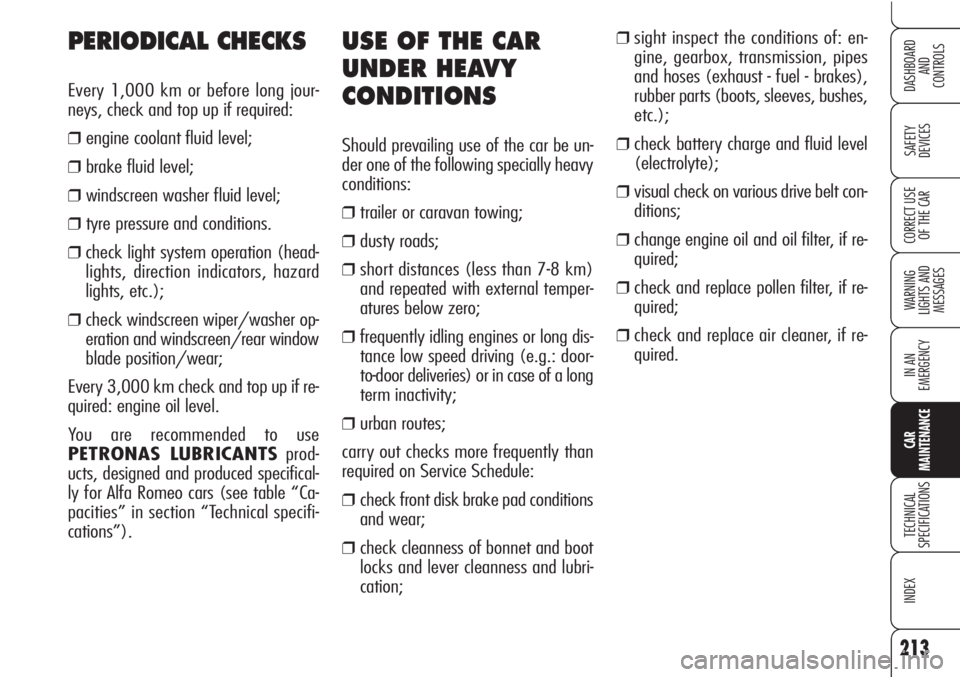
213
SAFETY
DEVICES
WARNING
LIGHTS AND
MESSAGES
IN AN
EMERGENCY
CAR
MAINTENANCE
TECHNICAL
SPECIFICATIONS
INDEX
DASHBOARD
AND
CONTROLS
CORRECT USE
OF THE CAR
USE OF THE CAR
UNDER HEAVY
CONDITIONS
Should prevailing use of the car be un-
der one of the following specially heavy
conditions:
❒trailer or caravan towing;
❒dusty roads;
❒short distances (less than 7-8 km)
and repeated with external temper-
atures below zero;
❒frequently idling engines or long dis-
tance low speed driving (e.g.: door-
to-door deliveries) or in case of a long
term inactivity;
❒urban routes;
carry out checks more frequently than
required on Service Schedule:
❒check front disk brake pad conditions
and wear;
❒check cleanness of bonnet and boot
locks and lever cleanness and lubri-
cation;
❒sight inspect the conditions of: en-
gine, gearbox, transmission, pipes
and hoses (exhaust - fuel - brakes),
rubber parts (boots, sleeves, bushes,
etc.);
❒check battery charge and fluid level
(electrolyte);
❒visual check on various drive belt con-
ditions;
❒change engine oil and oil filter, if re-
quired;
❒check and replace pollen filter, if re-
quired;
❒check and replace air cleaner, if re-
quired.
PERIODICAL CHECKS
Every 1,000 km or before long jour-
neys, check and top up if required:
❒engine coolant fluid level;
❒brake fluid level;
❒windscreen washer fluid level;
❒tyre pressure and conditions.
❒check light system operation (head-
lights, direction indicators, hazard
lights, etc.);
❒check windscreen wiper/washer op-
eration and windscreen/rear window
blade position/wear;
Every 3,000 km check and top up if re-
quired: engine oil level.
You are recommended to use
PETRONAS LUBRICANTSprod-
ucts, designed and produced specifical-
ly for Alfa Romeo cars (see table “Ca-
pacities” in section “Technical specifi-
cations”).
Page 216 of 271
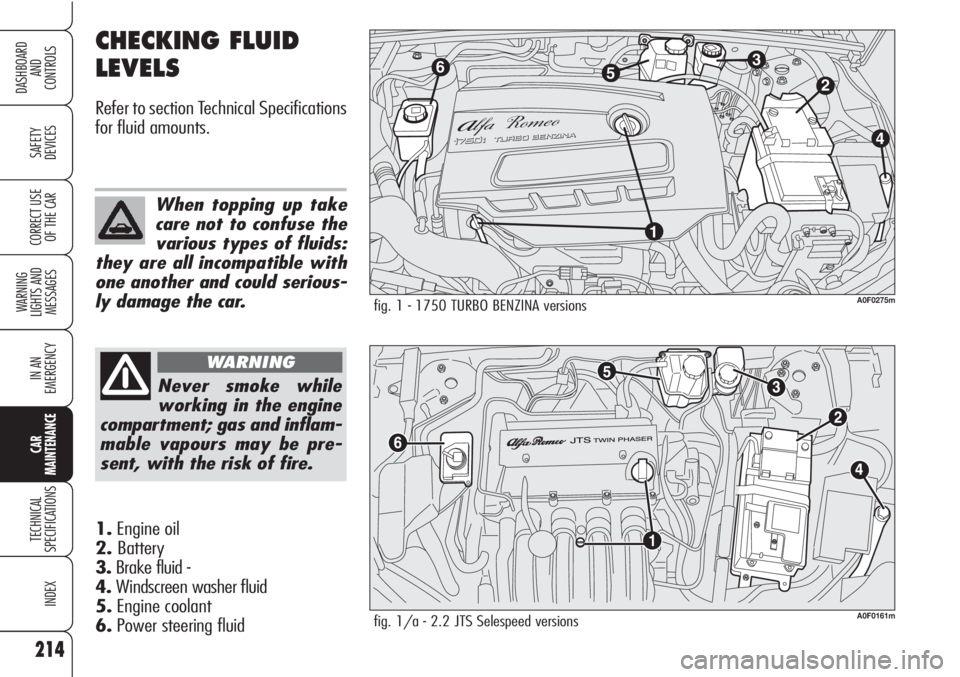
214
SAFETY
DEVICES
WARNING
LIGHTS AND
MESSAGES
IN AN
EMERGENCY
CAR
MAINTENANCE
TECHNICAL
SPECIFICATIONS
INDEX
DASHBOARD
AND
CONTROLS
CORRECT USE
OF THE CAR
CHECKING FLUID
LEVELS
Refer to section Technical Specifications
for fluid amounts.
fig. 1 - 1750 TURBO BENZINA versions
2
4
1 6
53
A0F0275m
Never smoke while
working in the engine
compartment; gas and inflam-
mable vapours may be pre-
sent, with the risk of fire.
WARNING
When topping up take
care not to confuse the
various types of fluids:
they are all incompatible with
one another and could serious-
ly damage the car.
1.Engine oil
2.Battery
3.Brake fluid -
4.Windscreen washer fluid
5.Engine coolant
6.Power steering fluid
fig. 1/a - 2.2 JTS Selespeed versionsA0F0161m
Page 217 of 271
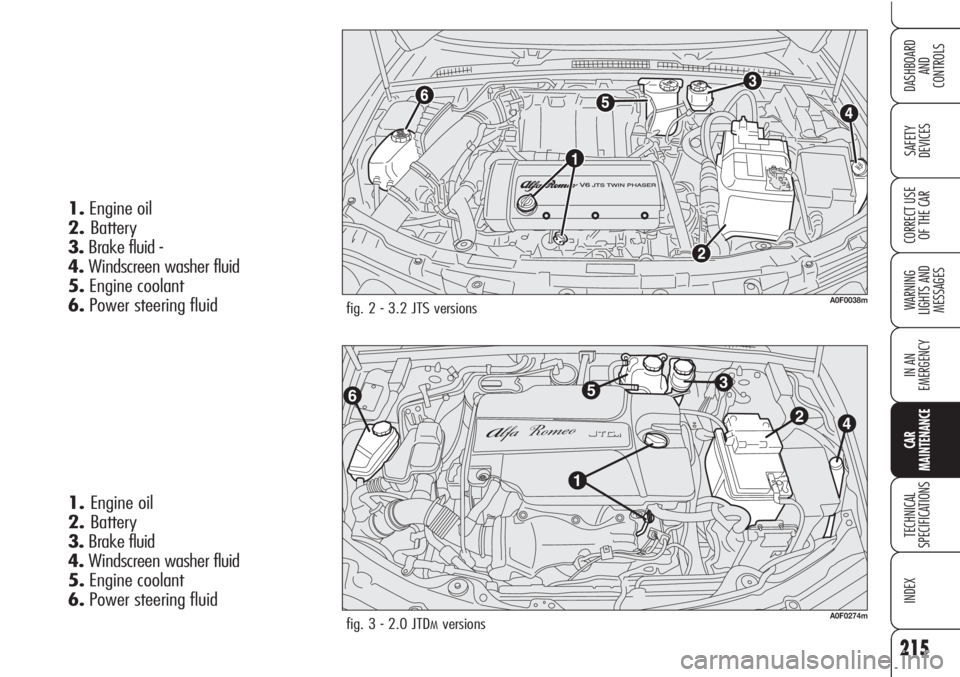
215
SAFETY
DEVICES
WARNING
LIGHTS AND
MESSAGES
IN AN
EMERGENCY
CAR
MAINTENANCE
TECHNICAL
SPECIFICATIONS
INDEX
DASHBOARD
AND
CONTROLS
CORRECT USE
OF THE CAR
1.Engine oil
2.Battery
3.Brake fluid -
4.Windscreen washer fluid
5.Engine coolant
6.Power steering fluid
fig. 2 - 3.2 JTS versionsA0F0038m
fig. 3 - 2.0 JTDMversions
653
2
4
1
A0F0274m
1.Engine oil
2.Battery
3.Brake fluid
4.Windscreen washer fluid
5.Engine coolant
6.Power steering fluid